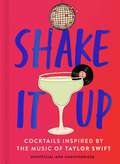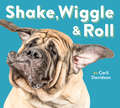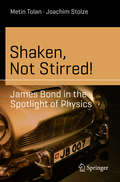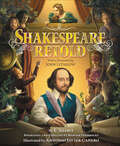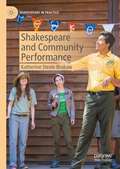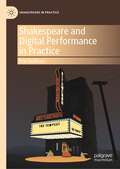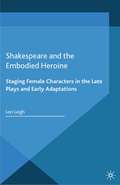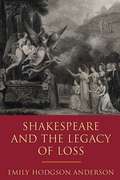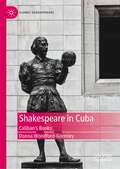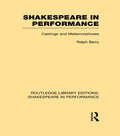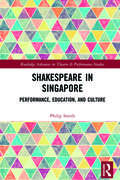- Table View
- List View
Shake It Up: Delicious cocktails inspired by the music of Taylor Swift
by WelbeckTake a trip into the Taylor-verse with this collection of delicious cocktail recipes inspired by the songs of Taylor Swift. Featuring 65 cocktail recipes alongside top tips and stunning Taylor-inspired illustrations, this is a celebration of pop music's finest songbook and the perfect collection for the Swiftie in your life.Cocktails include:I Knew You Were DoubleWe Are Never Ever Getting Back TequilaMr. Perfectly WineNew Rum-anticsGetaway SidecarCruel SlammerFizz The Damn SeasonThe Last Great American DaiquiriAnd many more.
Shake It Up: Delicious cocktails inspired by the music of Taylor Swift
by WelbeckTake a trip into the Taylor-verse with this collection of delicious cocktail recipes inspired by the songs of Taylor Swift. Featuring 65 cocktail recipes alongside top tips and stunning Taylor-inspired illustrations, this is a celebration of pop music's finest songbook and the perfect collection for the Swiftie in your life.Cocktails include:I Knew You Were DoubleWe Are Never Ever Getting Back TequilaMr. Perfectly WineNew Rum-anticsGetaway SidecarCruel SlammerFizz The Damn SeasonThe Last Great American DaiquiriAnd many more.
Shake, Wiggle & Roll
by Carli DavidsonIn Shake, Wiggle & Roll, babies and toddlers will be moving and grooving with playful pups as they show off favorite doggie moves, from chomping and chewing to jumping and leaping. With lively images from the lens of expert animal photographer Carli Davidson, this sturdy book is perfect for the very youngest readers—and fun for the whole family.
Shaken, Not Stirred!: James Bond in the Spotlight of Physics (Science and Fiction)
by Joachim Stolze Metin TolanHow do James Bond’s X-ray glasses work, the ones he uses to see whether the lady at the roulette table has a pistol concealed in her underwear? Is it really possible to launch oneself into the air and catch up with a plane that is free-falling towards the earth? Or to shoot down a helicopter with a pistol? In this lively and informative book, Germany's boldest physics professor Metin Tolan analyses the stunts and gadgets of the 007 films and even answers the question of all questions: Why does Bond drink his vodka martini shaken, not stirred? "So much entertaining science is a rare thing." Spiegel Online
Shakescenes: Shakespeare for Two
by William Shakespeare John Brown35 scenes from Shakespeare are presented in newly-edited texts, with notes which clarify meanings, topical references, puns, ambiguities, etc. A brief description of characters and situation prefaces each scene, and is followed by a commentary which discusses its major acting challenges and opportunities. Each scene has been chosen for its independent life requiring only the simplest of stage properties and the barest of spaces.
Shakespeare & Company: When Action is Eloquence
by Tina Packer Bella MerlinShakespeare & Company: When Action is Eloquence is the first comprehensive insight into this internationally acclaimed company founded in 1978 in Lenox, Massachusetts, by actor-director Tina Packer and voice pioneer Kristin Linklater, with the transformative power of Shakespeare’s language at its heart. Why act Shakespeare? What’s his relevance in the twenty-first century? Compelling answers to these questions lie at the center of this highly accessible journey into Shakespeare & Company’s aesthetics and practice. Drawing on hitherto unpublished material – including notebooks, lectures, interviews, rehearsal diaries – and the Company’s newly collated archive, this book provides insight into a working theatre company and sheds light on the role Shakespeare plays in our modern world. It also details: Shakespeare & Company’s founding and early history Its aesthetic based on the Elizabethan theatre’s principles of the Art of Rhetoric; Structure of the Verse; Voice and Movement; Clown; Fight; and Actor/Audience Relationship Vocational components of its Training Intensives Practical pedagogy of its Education programs Insights into its unique approaches to Performance Impact and legacy of its three lifetime founding members: Dennis Krausnick (Director of Training), Kevin G. Coleman (Director of Education) and Tina Packer (founding artistic director). Actors, directors, students, educators, scholars and theatre-lovers alike will find practical acting strategies, inspirational approaches to theatre making and lively insights into the sustaining of a unique and robust theatre company that has been thriving for over 40 years.
Shakespeare On Film
by Russell JacksonFilm adaptations of Shakespeare's plays are increasingly popular and now figure prominently in the study of his work and its reception. This lively Companion is a collection of critical and historical essays on the films adapted from, and inspired by, Shakespeare's plays. An international team of leading scholars discuss Shakespearean films from a variety of perspectives: as works of art in their own right; as products of the international movie industry; in terms of cinematic and theatrical genres; and as the work of particular directors from Laurence Olivier and Orson Welles to Franco Zeffirelli and Kenneth Branagh. They also consider specific issues such as the portrayal of Shakespeare's women and the supernatural. The emphasis is on feature films for cinema, rather than television, with strong coverage of Hamlet, Richard III, Macbeth, King Lear and Romeo and Juliet. A guide to further reading and a useful filmography are also provided.
Shakespeare Retold
by E. NesbitA beautifully illustrated collection of prose retellings of seven Shakespeare plays will bring the Bard to life for young readers. Not only is this a beautiful keepsake edition, full of gorgeous illustrations by Antonio Javier Caparo, but the prose retellings by beloved classic children’s book author E. Nesbit are an excellent tool to introduce children to the complex language of Shakespeare.A foreword by John Lithgow touches on his own childhood as a Shakespearean actor and the importance of Shakespeare. The book contains extensive support materials, including a biography, a timeline of Shakespeare’s life, and further recommended readings.In this volume, you will find:Romeo and JulietA Midsummer Night’s DreamTwelfth NightHamletMacbethThe TempestMuch Ado About Nothing
Shakespeare Without Tears
by Margaret WebsterA prominent producer-director of Shakespeare's plays writes with wit and verve about the Elizabethan theater and subsequent modifications in theatrical practice, differences between actors and audiences in Shakespeare's day and ours, and more "There is not an obscure or otherwise dull page in the book." -- N.Y. Times Book Review.
Shakespeare and Antiblack World-Making (Reproducing Shakespeare)
by Matthieu ChapmanThis book is about Shakespeare&’s role in sustaining the antiblack paradigm of modernity. This work re-reads both Shakespearean texts and performances from the 16th century to the present to argue that American and English societies have deployed Shakespeare for four hundred years as a mechanism to construct and reinforce paradigmatic antiblackness. Framed within the author&’s experiences as a Black scholar, actor, and director of Shakespeare and using both contemporary Critical Race Theory (CRT), as well as Pre-Modern Critical Race Studies (PCRS), this book uses civil society&’s engagement with and performance of Shakespeare in various times and places to reveal the continuum of antiblackness that predates chattel slavery in America and contributes to antiblack world-making across oceans and centuries.
Shakespeare and Celebrity Cultures (Routledge Advances in Theatre & Performance Studies)
by Jennifer HollThis book argues that Shakespeare and various cultures of celebrity have enjoyed a ceaselessly adaptive, symbiotic relationship since the final decade of the sixteenth century, through which each entity has contributed to the vitality and adaptability of the other. In five chapters, Jennifer Holl explores the early modern culture of theatrical celebrity and its resonances in print and performance, especially in Shakespeare’s interrogations of this emerging phenomenon in sonnets and histories, before moving on to examine the ways that shifting cultures of stage, film, and digital celebrity have perpetually recreated the Shakespeare, or even the #shakespeare, with whom audiences continue to interact. Situated at an intersection of multiple critical conversations, this book will be of great interest to scholars and graduate students of Shakespeare and Shakespearean appropriations, early modern theater, and celebrity studies.
Shakespeare and Child's Play: Performing Lost Boys on Stage and Screen
by Carol Chillington RutterShakespeare wrote more than fifty parts for children, amounting to the first comprehensive portrait of childhood in the English theatre. Focusing mostly on boys, he put sons against fathers, servants against masters, innocence against experience, testing the notion of masculinity, manners, morals, and the limits of patriarchal power. He explored the nature of relationships and ideas about parenting in terms of nature and nurture, permissiveness and discipline, innocence and evil. He wrote about education, adolescent rebellion, delinquency, fostering, and child-killing, as well as the idea of the redemptive child who ‘cures’ diseased adult imaginations. ‘Childness’ – the essential nature of being a child – remains a vital critical issue for us today. In Shakespeare and Child’s-Play Carol Rutter shows how recent performances on stage and film have used the range of Shakespeare’s insights in order to re-examine and re-think these issues in terms of today’s society and culture.
Shakespeare and Commedia dell'Arte: Play by Play
by Artemis PreeshlShakespeare and Commedia dell’Arte examines the ongoing influence of commedia dell’arte on Shakespeare’s plays. Exploring the influence of commedia dell’arte improvisation, sight gags, and wordplay on the development of Shakespeare’s plays, Artemis Preeshl blends historical research with extensive practical experience to demonstrate how these techniques might be applied when producing some of Shakespeare's best-known works today. Each chapter focuses on a specific play, from A Midsummer Night’s Dream to The Winter’s Tale, drawing out elements of commedia dell’arte style in the playscripts and in contemporary performance. Including contemporary directors’ notes and interviews with actors and audience members alongside Elizabethan reviews, criticism, and commentary, Shakespeare and Commedia dell’Arte presents an invaluable resource for scholars and students of Renaissance theatre.
Shakespeare and Community Performance (Shakespeare in Practice)
by Katherine Steele BrokawThis book explores how productions of Shakespearean plays create meaning in specific communities, with special attention to issues of access, adaptation, and activism. Instead of focusing on large professional companies, it analyzes performances put on by community theatres and grassroots companies, and in applied drama projects. It looks at Shakespearean productions created by marginalized populations in Greater London, Harlem, and Los Angeles, a Hamlet staged in the remote Faroe Islands, and eco-theatre made in California’s Yosemite National Park. The book investigates why different communities perform Shakespeare, and what challenges, opportunities, and triumphs accompany the processes of theatrical production for both the artists and the communities in which they are embedded.
Shakespeare and Digital Performance in Practice (Shakespeare in Practice)
by Erin SullivanShakespeare and Digital Performance in Practice explores the impact of digital technologies on the theatrical performance of Shakespeare in the twenty-first century, both in terms of widening cultural access and developing new forms of artistry. Through close analysis of dozens of productions, both high-profile and lesser known, it examines the rise of live broadcasting and recording in the theatre, the growing use of live video feeds and dynamic projections on the mainstream stage, and experiments in born-digital theatre-making, including social media, virtual reality, and video-conferencing adaptations. In doing so, it argues that technologically adventurous performances of Shakespeare allow performers and audiences to test what they believe theatre to be, as well as to reflect on what it means to be present—with a work of art, with others, with oneself—in an increasingly online world.
Shakespeare and Indian Cinemas: "Local Habitations" (Routledge Studies in Shakespeare)
by Poonam Trivedi Paromita ChakravartiThis book is the first to explore the rich archive of Shakespeare in Indian cinemas, including less familiar, Indian language cinemas to contribute to the assessment of the expanding repertoire of Shakespeare films worldwide. Essays cover mainstream and regional Indian cinemas such as the better known Tamil and Kannada, as well as the less familiar regions of the North Eastern states. The volume visits diverse filmic genres, starting from the earliest silent cinema, to diasporic films made for global audiences, television films, independent films, and documentaries, thus expanding the very notion of ‘Indian cinema’ while also looking at the different modalities of deploying Shakespeare specific to these genres. Shakespeareans and film scholars provide an alternative history of the development of Indian cinemas through its negotiations with Shakespeare focusing on the inter-textualities between Shakespearean theatre, regional cinema, performative traditions, and literary histories in India. The purpose is not to catalog examples of Shakespearean influence but to analyze the interplay of the aesthetic, historical, socio-political, and theoretical contexts in which Indian language films have turned to Shakespeare and to what purpose. The discussion extends from the content of the plays to the modes of their cinematic and intermedial translations. It thus tracks the intra–Indian flows and cross-currents between the various film industries, and intervenes in the politics of multiculturalism and inter/intraculturalism built up around Shakespearean appropriations. Contributing to current studies in global Shakespeare, this book marks a discursive shift in the way Shakespeare on screen is predominantly theorized, as well as how Indian cinema, particularly ‘Shakespeare in Indian cinema’ is understood.
Shakespeare and Sexuality in the Comedy of Morecambe & Wise (Palgrave Studies in Comedy)
by Stephen HamrickContextualizing the duo’s work within British comedy, Shakespeare criticism, the history of sexuality, and their own historical moment, this book offers the first sustained analysis of the 20th Century’s most successful double-act. Over the course of a forty-four-year career (1940-1984), Eric Morecambe & Ernie Wise appropriated snippets of verse, scenes, and other elements from seventeen of Shakespeare’s plays more than one-hundred-and-fifty times. Fashioning a kinder, more inclusive world, they deployed a vast array of elements connected to Shakespeare, his life, and institutions. Rejecting claims that they offer only nostalgic escapism, Hamrick analyses their work within contemporary contexts, including their engagement with many forms and genres, including Variety, the heritage industry, journalism, and more. ‘The Boys’ deploy Shakespeare to work through issues of class, sexuality, and violence. Lesbianism, drag, gay marriage, and a queer aesthetics emerge, helping to normalize homosexuality and complicate masculinity in the ‘permissive’ 1960s.
Shakespeare and Tourism (Routledge Advances in Theatre & Performance Studies)
by Valerie Clayman Pye Robert OrmsbyShakespeare and Tourism provides a dialogical mapping of Shakespeare studies and touristic theory through a collection of essays by scholars on a wide range of material. This volume examines how Shakespeare tourism has evolved since its inception, and how the phenomenon has been influenced and redefined by performance studies, the prevalence of the World Wide Web, developments in technology, and the globalization of Shakespearean performance. Current scholarship recognizes Shakespearean tourism as a thriving international industry, the result of centuries of efforts to attribute meanings associated with the playwright’s biography and literary prestige to sites for artistic pilgrimage and the consumption of cultural heritage. Through bringing Shakespeare and tourism studies into more explicit contact, this collection provides readers with a broad base for comparisons across time and location, and thereby encourages a thorough reconsideration of how we understand both fields.
Shakespeare and the Embodied Heroine: Staging Female Characters in the Late Plays and Early Adaptations (Palgrave Shakespeare Studies)
by L. LeighShakespeare and the Embodied Heroine is a bold new investigation of Shakespeare's female characters using the late plays and the early adaptations written and staged during the seventeenth and eighteenth century.
Shakespeare and the Imprints of Performance (History of Text Technologies)
by J. Gavin PaulWithin the study of drama, the question of how to relate text and performance—and what interpretive tools are best suited to analyzing them—is a longstanding and contentious one. Most scholars agree that reading a printed play is a means of dramatic realization absolutely unlike live performance, but everything else beyond this premise is contestable: how much authority to assign to playwrights, the extent to which texts and readings determine performance, and the capability of printed plays to communicate the possibilities of performance. Without denying that printed plays distort and fragment performance practice, this book negotiates an intractable debate by shifting attention to the ways in which these inevitable distortions can nevertheless enrich a reader's awareness of a play's performance potentialities. As author J. Gavin Paul demonstrates, printed plays can be more meaningfully engaged with actual performance than is typically assumed, via specific editorial principles and strategies. Focusing on the long history of Shakespearean editing, he develops the concept of the performancescape: a textual representation of performance potential that gives relative shape and stability to what is dynamic and multifarious.
Shakespeare and the Legacy of Loss
by Emily Hodgson AndersonHow do we recapture, or hold on to, the live performances we most love, and the talented artists and performers we most revere? Shakespeare and the Legacy of Loss tells the story of how 18th-century actors, novelists, and artists, key among them David Garrick, struggled with these questions through their reenactments of Shakespearean plays. For these artists, the resurgence of Shakespeare, a playwright whose works just decades earlier had nearly been erased, represented their own chance for eternal life. Despite the ephemeral nature of performance, Garrick and company would find a way to make Shakespeare, and through him the actor, rise again. In chapters featuring Othello, Richard III, Hamlet, The Winter’s Tale, and The Merchant of Venice, Emily Hodgson Anderson illuminates how Garrick’s performances of Shakespeare came to offer his contemporaries an alternative and even an antidote to the commemoration associated with the monument, the portrait, and the printed text. The first account to read 18th-century visual and textual references to Shakespeare alongside the performance history of his plays, this innovative study sheds new light on how we experience performance, and why we gravitate toward an art, and artists, we know will disappear.
Shakespeare and: The Merry Wives of Windsor (ISSN)
by Elizabeth SchaferSeismic shifts in the theatrical meanings of The Merry Wives of Windsor have taken place across the centuries as Shakespeare’s frequently performed play has relocated to Windsor across the world, journeying along the production/adaptation/appropriation continuum.This (eco-)performance history of Shakespeare’s The Merry Wives of Windsor not only offers the first in-depth analysis of the play in production, with a particular focus on the representation of merry women, but also utilises the comedy’s forest-aware dramaturgy to explore Mistress Page’s concept of being ‘frugal in my mirth’ in relation to sustainable theatre practices. Herne’s Oak – the fictitious tree in Windsor Forest where everyone meets in the final scene of the play – is utilised to enable a maverick but ecologically based reframing of the productions of Merry Wives analysed here.This study engages with gender, physical comedy, and cultural relocations of Windsor across the world to offer new insight into Merry Wives and its theatricality.
Shakespeare in Cuba: Caliban’s Books (Global Shakespeares)
by Donna Woodford-GormleyShakespeare in Cuba: Caliban’s Books explores how Shakespeare is consumed and appropriated in Cuba. It contributes to the underrepresented field of Latin American Shakespeares by applying the lens of cultural anthropophagy, a theory with Latin American roots, to explore how Cuban artists ingest and transform Shakespeare’s plays. By consuming these works and incorporating them into Cuban culture and literature, Cuban writers make the plays their own while also nourishing the source texts and giving Shakespeare a new afterlife.
Shakespeare in Performance: Castings and Metamorphoses (Routledge Library Editions: Shakespeare in Performance)
by Ralph BerryThese studies take stage history as a means of knowing the play. Half of the studies deal with casting - doubling, chorus and the crowd, the star of Hamlet and Measure for Measure. Then the transformations of dramatis personae are analyzed and The Tempest is viewed through the changing relationships of Prospero, Ariel and Caliban. Some of Shakespeare’s most original strategies for audience control are studied, such as Cordelia's asides in King Lear, Richard II’s subversive laughter and the scenic alternation of pleasure and duty in Henry IV. Performance is the realization of identity. The book draws on major productions up to 1992, just before the book was originally published.
Shakespeare in Singapore: Performance, Education, and Culture (Routledge Advances in Theatre & Performance Studies)
by Philip SmithShakespeare in Singapore provides the first detailed and sustained study of the role of Shakespeare in Singaporean theatre, education, and culture. This book tracks the role and development of Shakespeare in education from the founding of modern Singapore to the present day, drawing on sources such as government and school records, the entire span of Singapore's newspaper archives, playbills, interviews with educators and theatre professionals, and existing academic sources. By uniting the critical interest in Singaporean theatre with the substantial body of scholarship that concerns global Shakespeare, the author overs a broad, yet in-depth, exploration of the ways in which Singaporean approaches to Shakespeare have been shaped by, and respond to, cultural work going on elsewhere in Asia. A vital read for all students and scholars of Shakespeare, Shakespeare in Singapore offers a unique examination of the cultural impact of Shakespeare, beyond its usual footing in the Western world.
